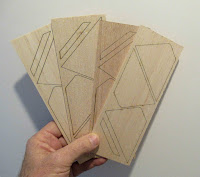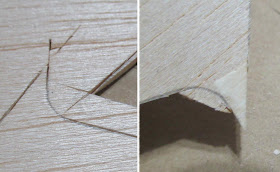The coupler is molded in red. At the center there is a thin shoulder that would show as red on the white and blue finished model. That center shoulder ring will have to the painted white.
The upper body tubes had a red outside layer.
The kit face card shows this tube as a medium blue. I wish this was a white tube!
I picked the best two tubes to be on the "show" models.
The nose cone mold lines took some scraping and filling to get a smooth finish.
The tube seams were filled on the two show models. The flight models didn't get the same fill.
The tube on the right shows the red after sanding the CWF filler. The red layer was really thin! These will need some gray primer and sanding to cover that spotty red.
Here I'm using the backside of the knife blade. No sense using the sharp side of the blade and dulling it.





















































